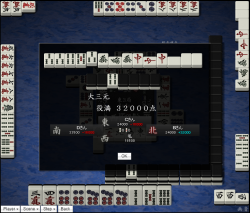Sekinin barai: Difference between revisions
(→Examples: add daisuushi pao example) |
mNo edit summary |
||
| Line 31: | Line 31: | ||
* [http://tenhou.net/0/?log=2012050716gm-0009-0000-85fac029&tw=0&ts=2 daisangen ron pao] | * [http://tenhou.net/0/?log=2012050716gm-0009-0000-85fac029&tw=0&ts=2 daisangen ron pao] | ||
* [http://tenhou.net/0/?log=2015010313gm-0009-0000-21763319&tw=2&ts=1 daisangen tsumo pao] | * [http://tenhou.net/0/?log=2015010313gm-0009-0000-21763319&tw=2&ts=1 daisangen tsumo pao] | ||
* [http://tenhou.net/0/?log=2015020203gm-0009-0000-83091f89&tw=3&ts=6 | * [http://tenhou.net/0/?log=2015020203gm-0009-0000-83091f89&tw=3&ts=6 daisuushii ron pao] | ||
* [http://tenhou.net/0/?log=2015012609gm-0089-0000-1956db78&tw=3&ts=10 suukantsu tsumo; no pao] | * [http://tenhou.net/0/?log=2015012609gm-0089-0000-1956db78&tw=3&ts=10 suukantsu tsumo; no pao] | ||
[[Category:Terminology]] | [[Category:Terminology]] | ||
[[Category:Game rules]] | [[Category:Game rules]] | ||
Revision as of 20:11, 28 June 2015
Sekinin barai 「責任払い」, or the rule of pao 「パオ」, enforces responsibility on particular a particular discard on a player. Such discards involve one that aids in the formation of an apparent yakuman. Another case applies to rinshan kaihou after a daiminkan. Under this rule, the "one responsible" is liable to making point payments, due to particular mahjong plays, such as upgrading a partial threat of yakuman into an actual yakuman. The most common example involves the yakuman, daisangen.
Sekinin barai for yakuman

If a called tile guarantees a yakuman for the caller, no matter how their hand is won later, the discarder of the called tile is considered liable and will have to pay extra for the win.
Point exchanges
Point exchanges using pao occur under these two conditions:
- If the yakuman is later won by tsumo, the entire value of the hand must be payed by the liable player, including the extra points for honba, as if ron was called against the player.
- If the yakuman is later won by ron against a non-liable player, this player must pay half the value of the yakuman, as well as the extra points for honba. The liable player must pay the other half of the yakuman.
With rules allowing multiple yakuman, sekinin barai may be invoked on some yakuman while some are scored normally. Point exchanges happen independently for each yakuman. Still, extra points for honba are payed only once. Whenever there are normally scored yakuman among the winning hand, honba payments are conducted normally.
Daisangen
If a player has two called mentsu of dragon tiles, then an open call for a koutsu/kantsu of the third dragon type upgrades the hand to an apparent daisangen, whether the tile call produces tenpai or not. The player dealing into the third dragon call is liable for the yakuman.
Daisuushii
A rarer case involves daisuushii. If a player has called three mentsu of wind tiles, then an open call for a koutsu/kantsu of the fourth wind type upgrades the hand to an apparent yakuman. The player dealing into the fourth dragon call is liable for the yakuman.
Suukantsu
Uncommon rules may invoke sekinin barai on the player discarding into the fourth kantsu of a suukantsu hand. This fourth kan must therefore be a daiminkan.
Sekinin barai for rinshan kaihou
Daiminkan pao for rinshan kaihou is an uncommon rule, but it is still used by a few organizations. Normally, rinshan kaihou would be scored as a regular tsumo under all circumstances. However, this modified rule may be used instead. If rinshan kaihou results from a daiminkan (kan called with a closed triplet), then the point exchange applies as if by "ron". In other words, the player who discarded the tile used for the open kan is liable for the whole hand, if rinshan occurs. If rinshan tsumo fails, then play continues as normally.
External links
- Sekinin barai in Japanese Wikipedia